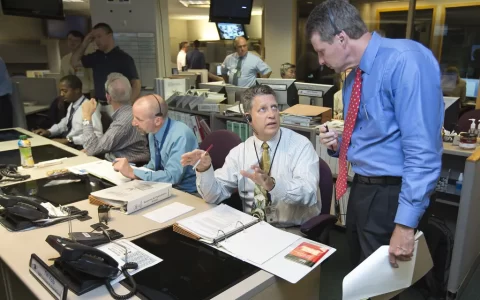
Triangles can be either shrinking or expanding in technical analysis. They function differently than the ‘classic’ ones, so understanding them is critical to correctly identifying them and entering trades. Although it’s challenging to show pictures, there aren’t any free demo account platforms out there, so you’ll have to try reading about it even if you can’t see it. Here is a quick run-through of what contracting triangles look like and how to enter on them:
The classic triangle version has two converging trend lines with equal highs and equal lows (i.e. parallel trend lines). The contracting version of the triangle only touches the same price twice, but the two points of intersection are not equal.
In a contracting triangle, the price will move sideways in this pattern: one swing high that is higher than the previous and a lower swing low that breaks the trend line. After doing this twice, the price tends to break out from either up or down – which means the trader gets a signal they can enter on. Note that when price moves up or down from these patterns, they tend to be strong moves, so entering here is good – but remember only to take trades where there has been an entry signal!
IMPORTANT: Triangular formations can only have five legs, regardless of the type. No more, no less. Elliott labelled the legs with letters (a-b-c-d-e) to demonstrate that they are corrective waves.
The A-C and B-D Trend Lines
The nature of a triangle is determined by how price behaves within the triangle. When traders create two trend lines, the a-c and b-d trend lines, this becomes obvious. The bottom line of the four waves is connected with these lines. Traders expect them to be on the right side of the chart as well.
More often than not, the lines trend downward. As a result, a contracting triangle may be spotted.
USDJPY and the 100 Level
The ideal location to search for a contracting triangle is ahead of significant psychological stages. These are frequently round figures.
Traders adore round numbers for some reason. Many individuals are familiar with levels such as parity (1) or 100. Take note of all open orders, stop-loss orders, take profit levels, and other outstanding transactions that could influence the market.
The ideal illustration is the USDJPY pair. It previously traded below the 80 mark several years ago. That is until the Bank of Japan got involved. The Japanese central bank launched an untried bond-buying plan. The initiative is still active today.
The government sells its bonds to the central bank under the floor. That’s called quantitative easing, or QE for short. It causes the currency to depreciate.
Nor was it. In an instant, the Japanese yen began trading across the board. The movement that started turned out to be very aggressive.
After a contracting triangle, price action occurs
Triangles have a variety of names depending on the trading theory utilized (for example, Elliott Waves Theory is rife with contracting triangles and their interpretation) or technical analysis approach.
Ascending or descending triangles are technical indicators that computer when a market is moving gradually upward or downward. They’re just contracting triangles that want to break higher or lower.
Conclusion
In the financial markets, triangles are abundant. They’re especially prevalent in the Forex market.
Because of high-frequency trading and the algorithms that govern it, most prices tend to consolidate ahead of major economic news. The issue is that crucial economic data appears far too frequently.
The market frequently consolidates due to this. When news is released on the wires, the algorithms are set up to buy or sell in large quantities.
As a novice trader using this strategy for the first time we highly recommend that you use a demo trading account to practice before making real money investments. Reputable brokers in Singapore, like Saxo forex broker, offer excellent free demo accounts.




